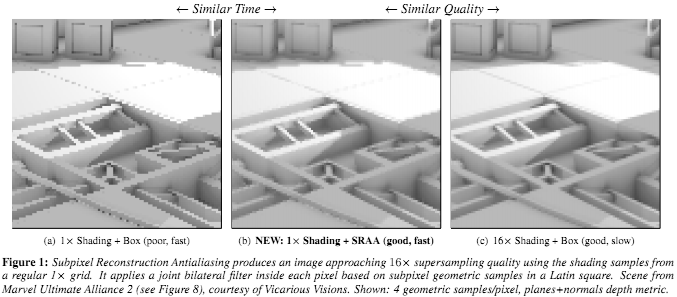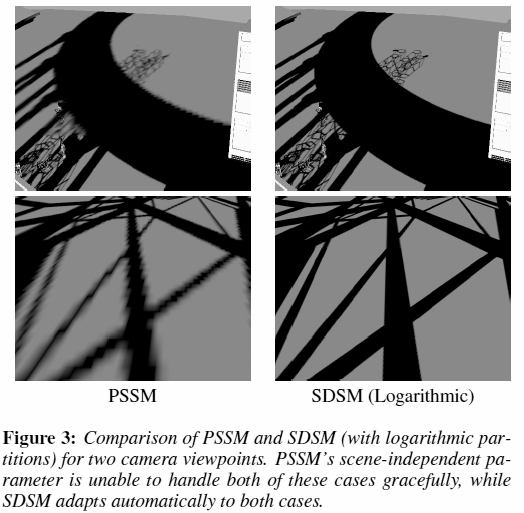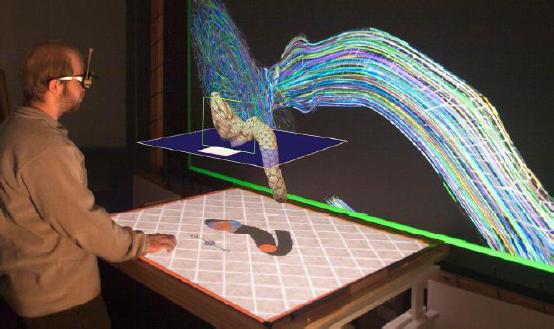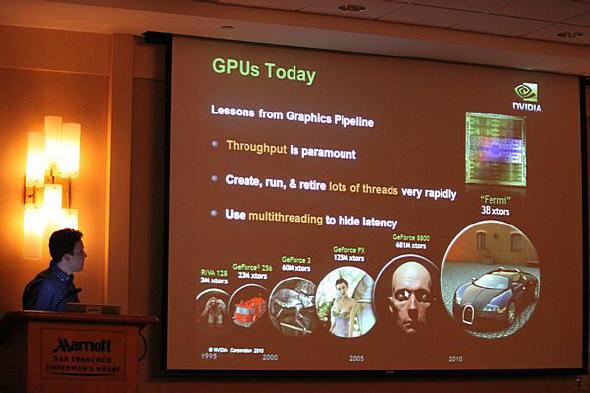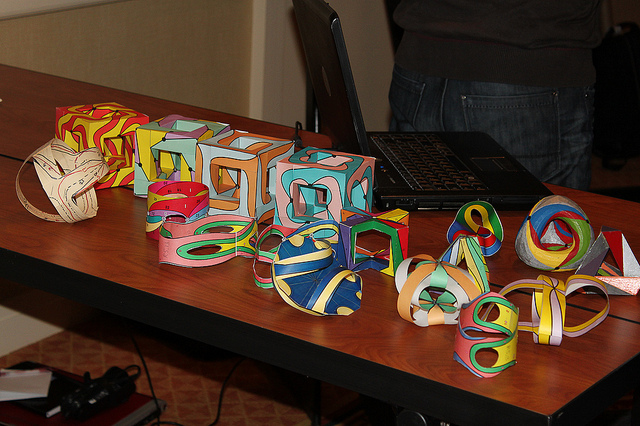At 18 courses, the SIGGRAPH 2011 course program is smaller than it has been in previous years, but what it lacks in size it more than makes up in quality. I’ll go over the list with a focus on courses of interest to game developers and/or real-time rendering researchers. If you are going to be attending SIGGRAPH, this should help you decide which courses to attend – if not, you’ll at least know which course notes and Encore videos to hunt down after the conference. Since this post is turning out to be quite long, I’ll split it up into several parts, spread out over the next few days.
UPDATES:
- 6/20/2011: Added details to Beyond Programmable Shading regarding Peter-Pike Sloan’s talk and the Software Rasterization on GPUs talk, as well as correcting the titles of several of the speakers.
- 6/21/2011: Added links to the papers High-Performance Software Rasterization on GPUs and VoxelPipe: A Programmable Pipeline for 3D Voxelization (the second link is the paper webpage – no PDF yet).
- 6/24/2011: Removed an incorrect detail about the DEAA technique.
- 7/10/2011: Updated the description of the Battlefield 3 / Need for Speed: The Run talk in the Advances in Real-Time Rendering in Games course.
Advances in Real-Time Rendering in Games (Part I & Part II)
Since 2006, this course series (organized by Natalya Tatarchuk, formerly at AMD and now at Bungie) has been my favorite thing to see at SIGGRAPH. Each year it has showcased new content from the cutting edge of game and IHV graphics development. Since Natalya joined Bungie, the emphasis has been less on IHV demos and more on games, which in my opinion makes the course even better – this year looks like the best yet! Part I starts with a brief introduction by Natalya and continues with four talks, each between 45 and 60 minutes in length:
- Bungie’s Graphics Secret Sauce, by Natalya Tatarchuk (Senior Graphics Researcher, Bungie) and Hao Chen (Engineering Lead, Bungie): Bungie’s talk will cover the graphics techniques developed for the award-winning game Halo: Reach, along with some new research undertaken for Bungie’s next title.
- Rendering in Cars 2, by Christopher Hall, Robert Hall, and David Edwards (Programmers at Avalanche Software): this talk will describe rendering techniques used in Cars 2: The Video Game, including offloading of post-processing and stereoscopy computations onto the Playstation 3’s SPUs. Other topics covered will include new developments in color precision, post processing effects, shadows, and the use of light probes.
- Secrets of CryENGINE 3 Graphics Technology, by Tiago Sousa (Principal R&D Graphics Engineer, Crytek), Nickolay Kasyan (Senior Rendering Engineer, Crytek), and Nicolas Schulz (Graphics Engineer, Crytek): an overview of the novel deferred lighting approach used in CryENGINE 3, along with an in-depth description of optimization techniques (both general and platform-specific), as well as stereoscopic 3D rendering and shadowing techniques.
- Two Uses of Voxels in LittleBigPlanet2’s Graphics Engine Alex Evans (CTO & Co-Founder, Media Molecule) and Anton Kirczenow (Senior Programmer, Media Molecule): this talk will describe a PlayStation 3-centric implementation of real-time dynamic scene voxelization and demonstrate two ways this voxel representation was used for rendering and special effects in the game LittleBigPlanet 2.
Part II also starts with a short introduction by Natalya; this is followed by five 30-50 minute talks:
- More Performance! Five Rendering Ideas from Battlefield 3 and Need For Speed: The Run, by John White (Senior Rendering Engineer, NFS) and Colin Barré-Brisebois (Rendering Engineer, BF3): this talk will cover several techniques from Battlefield 3 and Need for Speed: The Run designed to increase performance without sacrificing visual quality. These will include chroma sub-sampling for faster full-screen effects, a novel DirectX 9+ scatter-gather approach to bokeh rendering, improved temporally-stable dynamic ambient occlusion, HiZ reverse-reload for faster shadow and tile-based deferred shading on Xbox 360 (the last topic is a good complement to Christina Coffin’s GDC 2011 presentation giving Playstation 3 implementation details).
- Physically-based Lighting in Call of Duty: Black Ops, by Dimitar Lazarov (Lead Graphics Engineer, Treyarch): Dimitar will give an overview of the lighting architecture used in the Call of Duty games to achieve competitive visual quality at 60 frames per second. He will then describe the process of introducing a physically-based lighting model to the series in Call of Duty: Black Ops, from the premise behind the model to the specific benefits and issues encountered when integrating it into the game.
- Real-time Image Quilting: Arbitrary Material Blends, Invisible Seams, and No Repeats, by Hugh Malan (Graphics Programmer, CCP Games): A pixel shader-based image quilting technique which handles situations where standard environment texturing has problems: transitions between arbitrary neighbor materials, localized texture features due to custom geometry, and geometry-dependent edge effects. Production details such as vertex sharing and compaction techniques, texture storage options, and implementation issues for PC and console will also be covered.
- Dynamic Lighting in God of War III, by Vassily Filippov (Lead Game Programmer, SCEA Santa Monica): this talk will cover a novel forward lighting approach used in God of War III to create rich dynamically lit environments with dozens of light sources applied to a single pixel. The description will include a complete mathematical explanation of the algorithm, as well as implementation details such as the combination of multiple lights into a single aggregate light per vertex on the Playstation 3’s SPUs, a new light interpolation approach which improved lighting accuracy, and the application of the aggregate lights per pixel on the GPU. Usability constraints, edge cases and ways to reduce artifacts will be covered in detail.
- Pre-Integrated Skin Shading, by Eric Penner (Rendering Engineer, Electronic Arts Vancouver): Eric will describe a technique for rendering realistic skin in games, where rather than gathering neighboring light to simulate subsurface scattering, the effects of scattered light are pre-integrated. This allows for achieving the non-local effects of subsurface scattering using only locally stored information and a custom shading model.
Filtering Approaches for Real-Time Anti-Aliasing
From a theoretical standpoint, performing anti-aliasing as a post-process is locking the barn door after the horses have bolted. However, such techniques have recently proven to be surprisingly effective in practice – a flurry of algorithms, implementations, and variants have created one of the most important real-time rendering trends. For this course, the organizers – Jorge Jimenez (Real-Time Graphics Researcher, University of Zaragoza) and Diego Gutierrez (Associate Professor, University of Zaragoza) – have tracked down the inventors of pretty much every important technique in this area and recruited them to present their work:
- Morphological Antialiasing (MLAA), presented by Alexander Reshetov (Senior Staff Researcher, Intel) – this technique was presented as a paper at the High Performance Graphics (HPG) conference in 2009; the impressive results shown sparked most of the current interest in this general approach.
- A Directionally Adaptive Edge Anti-Aliasing Filter, presented by Jason Yang (Principal Member of Technical Staff , AMD). This technique was also presented as a HPG 2009 paper, and was influential as well.
- A GPU-friendly variant of MLAA, presented by Jorge Jimenez (Real-Time Graphics Researcher, University of Zaragoza). This variant was published in the book GPU Pro 2; the talk will also cover recent developments not included in the book.
- A hybrid CPU/GPU MLAA variant implemented for Costume Quest on the XBox 360, presented by Pete Demoreuille (Lead Programmer, Double Fine).
- The Playstation 3/SPU MLAA implementation first used in God of War III and subsequently made available to all Playstation 3 developers as part of the EDGE library. Tobias Berghoff (Senior Programmer, SCEE) will detail the implementation (including recent improvements), and Cedric Perthuis (Senior Staff Graphics Engineer, SCEA Santa Monica) will talk about how the technique was integrated into the God of War III engine.
- The SPU-based Anti-Aliasing technique (SPUAA) used on the Playstation 3 version of The Saboteur, presented by Henry Yu (Founder and CEO, Kalloc Studios). This technique has long been a topic of speculation among game developers, and will be discussed here for the first time.
- Subpixel Reconstruction Antialiasing (SRAA), presented by Morgan McGuire (Assistant Professor, Williams College and Visiting Scientist, NVIDIA). This technique was presented as a paper in the 2011 Symposium on Interactive 3D Graphics and Games (I3D).
- Fast approXimate Anti-Aliasing (FXAA), presented by Timothy Lottes (Developer Technology, NVIDIA). Fast and effective, this technique is currently being evaluated by many developers for inclusion in their games.
- Distance-to-Edge Anti-Aliasing (DEAA), presented by Hugh Malan (Graphics Programmer, CCP Games – formerly at Realtime Worlds).
- Geometry Buffer Anti-Aliasing (GBAA), presented by Emil Persson (also known as “Humus” – Graphics Programmer, Avalanche Studios).
- The Directionally Localized Anti-Aliasing (DLAA) technique used in Star Wars: The Force Unleashed 2, presented by Dmitry Andreev (Senior Rendering Engineer, Visceral Games – formerly at LucasArts).
- The temporal filtering anti-aliasing technique used in Crysis 2, presented by Tiago Sousa (Principal R&D Graphics Engineer, Crytek).
Beyond Programmable Shading (Part I & Part II)
Similarly to the “Advances in Real-Time Rendering” course, “Beyond Programmable Shading” is an “ensemble” course which has been presented annually at SIGGRAPH for several years running. As its name reflects, it deals with GPU-based graphics that go beyond the traditional graphics pipeline. This course has had uniformly high quality each year, and 2011 appears to be no exception. Part I starts with a 20-minute introduction by the course organizers – Aaron Lefohn (Lead Research Scientist, Intel) and Mike Houston (Fellow, AMD) – and continues with six 25-30 minute talks:
- Peter-Pike Sloan (Research & Development Lead, Disney Interactive Studios) will give a talk (title to be determined) about the applicability of current graphics research to games, discussing examples of research that works in games today, as well as research that does not work – and why.
- GPU Architecture, by Mike Houston (Fellow, AMD): an overview talk covering GPU architecture – unlike similar talks in previous iterations of the course, the architecture talk is extended this year to include heterogeneous architectures.
- Scheduling the Graphics Pipeline, by Jonathan Ragan-Kelley (PhD Student, MIT): this is an extension of a talk given by Jonathan in last year’s course – it will include significant new material, including more specifics on how scheduling works in particular GPU architectures.
- Parallel Programming for Real-Time Graphics, by Aaron Lefohn (Lead Research Scientist, Intel): compared to the talk of the same name in last year’s course, this talk will be significantly re-written and updated, including an increase in the number of concrete examples.
- Software Rasterization on GPUs, by Samuli Laine (Senior Research Scientist, NVIDIA) and Jacopo Pantaleoni (Senior Architect, NVIDIA): software rasterization on GPUs can be an effective way to bypass the limitations of the GPU’s fixed-function rasterizer. Each of the speakers will be discussing papers they will publish at HPG 2011 – in Samuli’s case, High-Performance Software Rasterization on GPUs and in Jacopo’s case, VoxelPipe: A Programmable Pipeline for 3D Voxelization.
- The course organizers are still in the process of finalizing the topic and speaker of the last talk.
Part II starts with a brief welcome and re-introduction by Mike Houston. This is followed by four 30-40 minute talks, all new to this course series:
- Toward a Blurry Rasterizer, by Jacob Munkberg (Research Scientist, Intel): this talk will cover the current state of the art in rasterizing triangles with motion and defocus blur – this is a very active area of research, which I suspect will yield some important GPU advances in the near future. Jacob has co-authored several important papers in this area – most notable are the Graphics Hardware 2007 paper Stochastic Rasterization using Time-Continuous Triangles and the HPG 2011 paper Hierarchical Stochastic Motion Blur Rasterization.
- Order-Independent Transparency, by Marco Salvi (Research Scientist, Intel): similarly to the previous talk, this covers the current state of the art in an important topic on which the speaker has considerable expertise. Of Marco’s work on the topic, most notable is the HPG 2011 paper Adaptive Transparency (not yet available online but his GDC 2011 talk on the topic – including source code – is available).
- Interactive Global Illumination, by Chris Wyman (Associate Professor, University of Iowa): this is the third “state-of-the-art talk” covering a relatively broad topic. Chris’ publications page includes numerous papers on this topic, some including source code.
- User-Defined Pipelines for Ray Tracing, by Steven Parker (Director of High Performance Computing and Computational Graphics, NVIDIA): this is a more tightly focused talk than the previous three. It has the potential to be quite interesting, given the speaker’s central role in the development of the Optix ray tracing system (he was the first author on the SIGGRAPH 2010 paper) as well as his area of responsibility at NVIDIA.
The course closes with a 15-minute wrap-up talk by the organizers (on the topic “What’s Next for Interactive Rendering Research?”), followed by a 45-minute panel discussion between the various course speakers.
I’ll continue going over the remaining SIGGRAPH 2011 courses in my next few blog posts.
